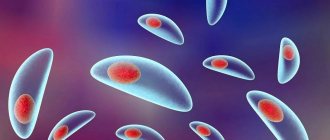Description of the drug OLANZAPINE
Use with extreme caution when increasing the activity of AST and ALT in patients with insufficiency of liver function, limited functional reserve of the liver, or in patients receiving treatment with potentially hepatotoxic drugs. If the activity of AST and/or ALT increases during treatment with olanzapine, careful monitoring of the patient is required and, if necessary, dose reduction.
Use with caution in patients with a history of epileptic seizures or exposed to factors that lower the seizure threshold.
Use with caution in patients with a low number of leukocytes and/or neutrophils due to various reasons; with signs of suppression/toxic impairment of bone marrow function under the influence of drugs in the anamnesis; with suppression of bone marrow function due to concomitant disease, radiotherapy or chemotherapy in history; with hypereosinophilia or myeloproliferative disease. In clinical studies, the use of olanzapine in patients with a history of clozapine-dependent neutropenia or agranulocytosis was not accompanied by relapses of these disorders.
Use with caution in patients with clinical manifestations of prostatic hyperplasia, paralytic ileus, angle-closure glaucoma and similar conditions.
When treated with antipsychotics, including olanzapine, the development of NMS is possible. Clinical manifestations of NMS or a significant increase in body temperature without other symptoms of this syndrome require the abolition of all antipsychotics, including olanzapine.
With long-term therapy with antipsychotics, there is a risk of developing tardive dyskinesia. If signs of tardive dyskinesia develop, it is recommended to reduce the dose or discontinue olanzapine. Symptoms of tardive dyskinesia may appear or worsen after discontinuation of therapy.
Given the nature of the action of olanzapine on the central nervous system, it should be used with caution in combination with other centrally acting drugs and ethanol.
The safety and effectiveness of olanzapine in patients under 18 years of age have not been studied.
Impact on the ability to drive vehicles and operate machinery
During the treatment period, caution should be exercised in engaging in activities that require concentration and high speed of psychomotor reactions.
Olanzapine (Zalasta, Zyprexa, Egolanza)
Clinical and pharmacological group
Antipsychotic drug (neuroleptic)
Contraindications
- lactation period;
- children under 18 years of age;
- hypersensitivity to the components of the drug.
The drug should be prescribed with caution for liver failure, prostatic hyperplasia, angle-closure glaucoma, epilepsy, myelosuppression (including leukopenia, neutropenia), myeloproliferative diseases, hypereosinophilic syndrome, paralytic ileus, pregnancy.
Dosage
The drug is taken orally, regardless of food intake, at a dose of 5-20 mg/day.
For schizophrenia in adults, the recommended initial dose is 10 mg/day.
For acute mania associated with bipolar disorders in adults - 15 mg 1 time / day as monotherapy or 10 mg 1 time / day in combination with lithium or valproic acid (maintenance therapy at the same dose).
For depression associated with bipolar disorders in adults - 5 mg 1 time / day in combination with 20 mg fluoxetine (doses can be changed if necessary).
For elderly patients, patients with risk factors (including severe chronic renal failure or moderate liver failure), with a combination of risk factors (female gender, old age, non-smokers), in whom the metabolism of olanzapine may be slowed, it is recommended to reduce the initial dose to 5 mg/day.
Side effects
The incidence of side effects is determined as follows: very often (≥ 10%), often (≥ 1% and <10%), infrequently (≥ 0.1% and <1%), rarely (≥ 0.01% and < 0.1%), very rare (<0.01%).
Somnolence and weight gain were very common in clinical studies; in 34% - hyperprolactinemia (mild and transient). Clinical manifestations of hyperprolactinemia were rare.
Common: dizziness, asthenia, akathisia, increased appetite, peripheral edema, orthostatic hypotension, dry oral mucosa, constipation.
Rarely: transient, asymptomatic increase in ALT, AST activity.
In isolated cases: an increase in plasma glucose levels of more than 200 mg/dl (suspicion of diabetes mellitus), 160 - 200 mg/dl (suspicion of hyperglycemia) in patients with an initial glucose concentration of less than 140 mg/dl.
Cases of increased levels of triglycerides (by 20 mg/dl from baseline), cholesterol (by 0.4 mg/dl from baseline), and asymptomatic eosinophilia (isolated cases) were observed.
In patients with psychosis due to dementia: very often - gait disturbance and falls; often - urinary incontinence and pneumonia.
In patients with psychosis induced by taking a dopamine agonist in Parkinson's disease: very often - increased symptoms of parkinsonism and hallucinations.
In patients with bipolar mania (receiving the drug in combination with lithium or valproic acid): very often - weight gain, dry oral mucosa, increased appetite, tremor; often - speech disorder.
The following are the side effects observed in clinical studies and post-marketing experience.
From the cardiovascular system: often - orthostatic hypotension; infrequently - bradycardia; very rarely - venous thromboembolism.
From the digestive system: often - constipation, dryness of the oral mucosa, increased appetite; rarely - hepatitis; very rarely - pancreatitis, jaundice.
Metabolism: often - peripheral edema; very rarely - diabetic coma, diabetic ketoacidosis. hyperglycemia, hypercholesterolemia, hypertriglyceridemia.
From the musculoskeletal system: very rarely - rhabdomyolysis.
From the nervous system: very often - drowsiness; often - akathisia, dizziness, asthenia; rarely - convulsions.
From the skin: rarely - rash.
From the genitourinary system: very rarely - priapism.
From the hematopoietic system: often - eosinophilia, rarely - leukopenia, very rarely - thrombocytopenia.
In terms of laboratory parameters: very often - hyperprolactinemia; often - increased activity of ALT, AST, hyperglycemia; very rarely - hyperbilirubinemia, increased alkaline phosphatase activity.
Other: very often - weight gain, infrequently - photosensitivity, very rarely - allergic reactions, withdrawal syndrome.
Overdose
Symptoms: tachycardia, agitation/aggression, articulation disorder, extrapyramidal disorders, disturbances of consciousness (from sedation to coma), delirium, convulsions, neuroleptic malignant syndrome, respiratory depression, aspiration, increased or decreased blood pressure, arrhythmias, cardiac and respiratory arrest.
Treatment: gastric lavage, administration of activated carbon, symptomatic treatment, maintaining respiratory function.
You should not use sympathomimetics (including epinephrine, dopamine), which are beta-adrenergic receptor agonists (stimulation of these receptors can aggravate the decrease in blood pressure).
The minimum dose for acute overdose with fatal outcome was 450 mg, the maximum dose with a favorable outcome (survival) was 1500 mg.
Drug interactions
Inducers or inhibitors of the CYP 1A2 isoenzyme may alter the metabolism of olanzapine.
The clearance of olanzapine increases in smoking patients and with simultaneous use of carbamazepine (CYP1A2 activity increases).
Ethanol did not affect the pharmacokinetics of olanzapine at steady state, however, taking ethanol together with olanzapine may be accompanied by an increase in the pharmacological effects of olanzapine (sedation).
Activated carbon reduces the bioavailability of olanzapine by up to 50-60%.
Fluoxetine (60 mg once or 60 mg daily for 8 days) increases the Cmax of olanzapine by 16% and reduces clearance by 16%, which has no clinical significance (no dose adjustment of olanzapine is required).
Fluvoxamine (CYP 1A2 inhibitor), reducing the clearance of olanzapine, increases the Cmax of olanzapine in non-smoking women by 54% and by 77% in smoking men, AUC by 52% and 108%, respectively (a dose reduction of olanzapine is required).
Olanzapine slightly inhibits the formation of valproic acid glucuronide (the main metabolic pathway). Valproic acid has little effect on the metabolism of olanzapine. A clinically significant pharmacokinetic interaction between olanzapine and valproic acid is unlikely.
special instructions
When treated with neuroleptics (including olanzapine), neuroleptic malignant syndrome may develop (hyperthermia, muscle rigidity, changes in mental status, autonomic disorders, including unstable pulse or blood pressure, tachycardia, cardiac arrhythmias, increased sweating; increased CPK activity , myoglobinuria as a result of rhabdomyolysis, acute renal failure).
If clinical manifestations of neuroleptic malignant syndrome are detected (including hyperthermia without other symptoms), discontinuation of olanzapine is required.
If signs of tardive dyskinesia develop, it is recommended to reduce the dose or discontinue olanzapine. Symptoms of tardive dyskinesia may increase or manifest after discontinuation of the drug.
When taking olanzapine (in studies), cerebrovascular events (stroke, transient ischemic attack), including deaths, were observed in elderly patients with psychosis due to dementia. These patients had previous risk factors (history of cerebrovascular disorders, transient ischemic attack, arterial hypertension, smoking), as well as concomitant diseases and/or medications that were temporally associated with cerebrovascular disorders. Olanzapine is not recommended for the treatment of patients with psychosis due to dementia.
Particular caution is required when ALT and/or AST levels are elevated in patients with liver failure or receiving treatment with potentially hepatotoxic drugs. Monitoring the patient and, if necessary, reducing the dose is required.
There is a higher prevalence of diabetes mellitus in patients with schizophrenia. Very rarely, cases of hyperglycemia, development of diabetes mellitus or exacerbation of pre-existing diabetes mellitus, ketoacidosis and diabetic coma have been reported. A causal relationship between antipsychotic drugs and these conditions has not been established. Clinical monitoring of patients with diabetes mellitus or with risk factors for its development is recommended.
Olanzapine should be used with caution in patients with a history of epileptic seizures or in the presence of factors that lower the seizure threshold.
Olanzapine should be used with caution in patients with a decrease in the number of leukocytes and/or neutrophils, with signs of suppression or toxic impairment of bone marrow function under the influence of drugs (history), with suppression of bone marrow function due to concomitant disease, radiotherapy or chemotherapy (in medical history); with hypereosinophilia or myeloproliferative disease.
The use of olanzapine in patients with clozapine-dependent neutropenia or agranulocytosis (history) was not accompanied by relapses of these disorders.
It is recommended to exercise caution when prescribing olanzapine to patients with symptomatic prostatic hypertrophy, paralytic ileus, and angle-closure glaucoma.
Olanzapine exhibits dopamine antagonism and, theoretically, may inhibit the effects of levodopa and dopamine agonists.
Caution should be exercised when using olanzapine in combination with other centrally acting drugs and ethanol.
Impact on the ability to drive vehicles and operate machinery
During the treatment period, care must be taken when driving vehicles and engaging in potentially hazardous activities that require increased concentration and speed of psychomotor reactions.
Pregnancy and lactation
The drug should be prescribed with caution during pregnancy.
If it is necessary to prescribe the drug during lactation, breastfeeding should be discontinued.
Use in childhood
Contraindicated in children and adolescents under 18 years of age.
For liver dysfunction
The drug should be prescribed with caution in case of liver failure.
Use in old age
For elderly patients, patients with risk factors (including severe chronic renal failure or moderate liver failure), with a combination of risk factors (female gender, old age, non-smokers), in whom the metabolism of olanzapine may be slowed, it is recommended to reduce the initial dose to 5 mg/day.
Conditions for dispensing from pharmacies
The drug is available with a prescription.
Storage conditions and periods
The drug should be stored in a dry place, protected from light, out of reach of children at a temperature not exceeding 25°C. Shelf life: 2 years.
Release form, composition and packaging
The tablets are light yellow to yellow in color, cylindrical, biconvex, with an “L” engraving on one side.
1 tab.
olanzapine 2.5 mg
Excipients: microcrystalline cellulose - 85.6 mg, lactose monohydrate - 17.2 mg, crospovidone - 1.1 mg, magnesium stearate - 1.1 mg.
7 pcs. — contour cell packaging (4) — cardboard packs.
The tablets are light yellow to yellow in color, cylindrical, biconvex, debossed with “FA20” on one side.
1 tab.
olanzapine 5 mg
Excipients: microcrystalline cellulose - 171.3 mg, lactose monohydrate - 34.3 mg, crospovidone - 2.2 mg, magnesium stearate - 2.2 mg.
7 pcs. — contour cell packaging (4) — cardboard packs.
The tablets are light yellow to yellow in color, cylindrical, biconvex, debossed with “F20C” on one side.
1 tab.
olanzapine 7.5 mg
Excipients: microcrystalline cellulose - 257 mg, lactose monohydrate - 51.6 mg, crospovidone - 3.2 mg, magnesium stearate - 3.2 mg.
7 pcs. — contour cell packaging (8) — cardboard packs.
The tablets are light yellow to yellow in color, cylindrical, biconvex, debossed with “N30C” on one side.
1 tab.
olanzapine 10 mg
Excipients: microcrystalline cellulose - 342.6 mg, lactose monohydrate - 68.8 mg, crospovidone - 4.3 mg, magnesium stearate - 4.3 mg.
7 pcs. — contour cell packaging (4) — cardboard packs.
Signs of withdrawal syndrome
They usually develop in the first four days after discontinuation or dose reduction, and then go away on their own. But one should not rely on the independent elimination of pathological symptoms - in some patients it lasts for several weeks. First of all, they resume the symptoms of the disease in the treatment of which Olanzapine was used - often more pronounced than they were previously observed. Also possible:
- hallucinations;
- neuropsychic agitation;
- anxiety;
- trembling of the torso, upper and lower extremities.
Other violations also arise from:
- gastrointestinal tract - nausea, diarrhea, abdominal pain, loss of appetite, change in taste;
- fasciculation of the tongue (involuntary twitching of its muscle fibers);
- change in voice timbre;
- increased salivation;
- difficulty swallowing.
Please note:
Often during olanzapine withdrawal the patient feels as if he has an acute respiratory viral infection. Headaches and muscle pains occur, and body temperature rises. The latter is often accompanied by chills - this condition is called fever. Photophobia may occur - unpleasant sensations due to light and, as a result, fear of it.
Indications and contraindications
Olanzapine is prescribed for:
- schizophrenia;
- bipolar disorders;
- psychoses.
The connection copes well with the tasks assigned to it. But it also has negative effects. This:
- lipid metabolism disorders;
- carbohydrate metabolism failures;
- pathological drowsiness;
- slowing down the reaction.
One of the side effects is the development of addiction with all the ensuing consequences. With prolonged use of Olanzapine, the body becomes insensitive to it . Because of this, you have to take a large dose of medicine, which is not correct.
Olanzapine, 5 mg, tablets, 30 pcs.
Suicide
The risk of suicide attempts in patients with schizophrenia and bipolar disorder type 1 is determined by these diseases themselves. In this regard, during pharmacotherapy, careful monitoring of those patients whose risk of suicide is especially high is required. When prescribing olanzapine, efforts should be made to minimize the number of tablets the patient takes to reduce the risk of overdose.
ZNS
NMS (potentially lethal symptom complex) can develop during treatment with any antipsychotics, including olanzapine. Clinical manifestations of NMS include a significant increase in body temperature, muscle rigidity, changes in mental status, and autonomic disturbances (unstable pulse or blood pressure, tachycardia, cardiac arrhythmias, increased sweating). Additional signs may include increased CPK activity, myoglobinuria (rhabdomyolysis), and acute renal failure. Clinical manifestations of NMS or a significant increase in body temperature without other symptoms of NMS require discontinuation of all antipsychotics, including olanzapine.
Tardive dyskinesia
In comparative studies, treatment with olanzapine was significantly less often accompanied by the development of dyskinesia requiring drug correction than the use of typical and other atypical neuroleptics. However, the risk of tardive dyskinesia should be taken into account during long-term therapy with antipsychotics. If signs of tardive dyskinesia develop, dose adjustment of the antipsychotic is recommended. It should be taken into account that when switching to olanzapine, symptoms of tardive dyskinesia may develop as a result of immediate withdrawal of previous therapy. Over time, the intensity of these symptoms may increase; moreover, these symptoms may develop after cessation of therapy.
Experience in elderly patients with dementia-related psychosis
The effectiveness of olanzapine in elderly patients with dementia-related psychosis has not been established. In this category of patients in placebo-controlled clinical trials, the incidence of deaths in the olanzapine group was higher than in the placebo group (3.5 versus 1.5%, respectively). Risk factors that may predispose this group of patients to higher mortality when treated with olanzapine include age >80 years, sedation, concomitant use with benzodiazepines, or the presence of pulmonary pathology (eg, pneumonia with or without aspiration).
There are insufficient data to establish differences in the incidence of cerebrovascular events and/or mortality (compared with placebo) and risk factors in this group of patients between oral and intramuscular olanzapine.
Parkinson's disease
The use of olanzapine is not recommended in the treatment of psychosis induced by dopamine receptor agonists in Parkinson's disease. In clinical studies in patients with dopamine receptor agonist drug-induced psychosis in Parkinson's disease, increased parkinsonian symptoms were very common (≥10%) and at a higher frequency than in the placebo group. Hallucinations were also reported very frequently (≥10%) and at a higher frequency than in the placebo group.
Liver dysfunction
In some cases, taking olanzapine, usually in the early stages of therapy, was accompanied by a transient, asymptomatic increase in the activity of hepatic transaminases (AST and ALT) in the blood serum. Rare cases of hepatitis have been reported. In addition, there have been isolated reports of cholestatic and mixed liver damage. Particular caution is required when increasing the activity of AST and/or ALT in the blood serum in patients with insufficiency of liver function, limited functional reserve of the liver, or in patients receiving treatment with potentially hepatotoxic drugs. If AST and/or ALT activity increases during treatment with olanzapine, careful monitoring of the patient is required and, if necessary, dose reduction. In cases of severe liver dysfunction caused by olanzapine, its use should be discontinued.
Hyperglycemia and diabetes mellitus
There is a higher prevalence of diabetes mellitus in patients with schizophrenia. As with some other antipsychotic drugs, there have been rare cases of hyperglycemia and decompensation of diabetes mellitus, in some cases accompanied by ketoacidosis and diabetic coma, incl. with fatal outcome. Close clinical monitoring of patients with diabetes mellitus and risk factors for developing diabetes mellitus is recommended.
Change in lipid profile
During placebo-controlled studies, undesirable lipid changes were observed in patients receiving olanzapine. Clinical observation is recommended (see "Side effects").
Development of the risk of sudden death
Clinical experience with all antipsychotics, including olanzapine, has shown a similar dose-dependent two-fold increase in the risk of death due to acute heart failure compared with deaths due to acute heart failure in patients not using antipsychotics.
Cerebrovascular adverse events, including stroke, in elderly patients with dementia
Cerebrovascular adverse events (eg, stroke, transient ischemic attack), including deaths, were observed in studies of olanzapine in elderly patients with psychosis associated with dementia. In placebo-controlled studies, there was a higher incidence of cerebrovascular adverse events in patients in the olanzapine group compared with the placebo group (1.3 vs. 0.4%, respectively). All patients with cerebrovascular events had previous risk factors for the development of cerebrovascular adverse events (for example, a previous case of a cerebrovascular adverse event or transient ischemic attack, arterial hypertension, smoking), as well as concomitant diseases and/or medications temporally associated with cerebrovascular adverse events. Olanzapine is not indicated for the treatment of patients with psychosis associated with dementia.
Convulsions
Olanzapine should be used with caution in patients with a history of seizures or exposure to factors that lower the seizure threshold. In such patients, seizures were rarely observed during olanzapine treatment.
M-anticholinergic activity
In clinical studies, olanzapine therapy was rarely accompanied by adverse reactions due to blockade of m-cholinergic receptors. However, clinical experience with olanzapine in patients with comorbidities is limited, and caution is recommended when prescribing olanzapine in patients with clinically significant prostatic hyperplasia, paralytic ileus, angle-closure glaucoma, and similar conditions.
Blockade of dopamine receptors
In vitro
Olanzapine exhibits dopamine receptor antagonism and, like other antipsychotics (neuroleptics), may theoretically inhibit the effects of levodopa and other dopamine receptor agonists.
Hematological changes
Olanzapine should be used with caution in patients with low levels of leukocytes and/or neutrophils in the blood; receiving drugs that can cause neutropenia; with suppression of bone marrow function due to disease, radiation or chemotherapy; as well as patients with eosinophilia and/or myeloproliferative diseases. Neutropenia has been reported primarily when olanzapine is combined with valproate.
In clinical studies, the use of olanzapine in patients with a history of clozapine-dependent neutropenia or agranulocytosis was not accompanied by relapses of these disorders. The development of neutropenia has been reported primarily during concomitant therapy with olanzapine and valproic acid.
QT interval
In clinical trials, clinically significant prolongation of the QT interval (QT interval with Frederick's correction (QTcF) >500 ms in patients with baseline value, QTcF <500 ms) was observed infrequently in patients receiving olanzapine, with no significant differences from placebo in the incidence of adverse events. phenomena from the heart. However, as with other antipsychotics, caution is recommended when using olanzapine in combination with drugs that can prolong the QT interval, especially in elderly patients with congenital prolongation of the QT interval, CHF, myocardial hypertrophy, hypokalemia and hypomagnesemia.
Cancellation of therapy
In case of abrupt discontinuation of olanzapine, acute development of sweating, insomnia, tremor, anxiety, nausea and vomiting has been reported extremely rarely (<0.01%).
Thromboembolism
Very rarely (<0.01%) the development of venous thromboembolism has been reported during olanzapine therapy. The presence of a cause-and-effect relationship between taking olanzapine and venous thromboembolism has not been established. However, given that patients with schizophrenia often have acquired risk factors for venous thromboembolism, it is necessary to conduct a cumulative assessment of all possible risk factors for the development of this complication, incl. immobilize patients and take necessary preventive measures.
General activity in relation to the central nervous system
Given the primary central nervous system effects of olanzapine, caution should be exercised when olanzapine is used in combination with other centrally acting drugs and alcohol.
Postural hypotension
Postural hypotension was observed infrequently in clinical studies of olanzapine in the elderly. As with other antipsychotics, periodic blood pressure monitoring is recommended when olanzapine is used in patients over 65 years of age.
Body mass
During treatment (up to 6 weeks) of the acute phase of schizophrenia, when in placebo-controlled trials of olanzapine, the percentage of patients who experienced a weight gain of ≥7% from baseline, the difference was statistically significant and was 29% in those taking olanzapine and only 3% in the placebo group. The mean weight gain in these patients treated with olanzapine during the acute phase was 2.8 kg. Body mass index (BMI) always increased clinically significantly in the study group. During long-term treatment of schizophrenia with olanzapine, weight gain averaged 5.4 kg; in 56% of patients in the test group, body weight increased by more than 7% from the baseline. For patients undergoing long-term treatment for bipolar disorder, the average weight gain was 3.8 kg, and the number of patients with a weight gain of more than 7% was 31%.
Hyperprolactinemia
In controlled clinical trials (no more than 12 weeks), an increase in prolactin levels in the blood was found in 30% of patients in the test group and 10.5% in the placebo group (control). The levels of increase in prolactin concentrations themselves were moderate. Identified clinical manifestations included: menstrual dysfunction (common), sexual dysfunction (particularly erectile dysfunction in men; decreased or loss of libido in men and women; abnormal orgasm) and breast disorders (uncommon).
Dysphagia
The appearance of esophageal motility disorders and aspiration are associated with the use of antipsychotic drugs. Aspiration pneumonia is a common cause of morbidity and mortality in patients with advanced Alzheimer's disease, requiring caution in these patients.
Body temperature regulation
Antipsychotic drugs are generally credited with interfering with the body's ability to control core body temperature. Appropriate caution should be used in patients taking olanzapine in environments that increase core body temperature. For example, they perform vigorous physical exercise, are exposed to high ambient temperatures, take any drugs with anticholinergic activity together with olanzapine, or are in conditions of dehydration (sweat intensely).
Children and teenagers under 18 years of age
Olanzapine is not recommended for use in children and adolescents under 18 years of age due to the lack of sufficient data on efficacy and safety. In short-term studies that were conducted in adolescents 13–17 years of age, there was a greater increase in body weight and changes in lipid and prolactin concentrations than in similar studies in adults.
Impact on the ability to drive vehicles and operate machinery.
Patients taking olanzapine should be warned about the dangers associated with operating machinery, including motor vehicles, as olanzapine may cause drowsiness and dizziness.
Content:
- Properties of Olanzapine
- Indications and contraindications
- Risks of developing withdrawal: how not to stop taking the medicine
- Signs of withdrawal syndrome
- Specific manifestations of withdrawal
- Olanzapine: how to stop it correctly
Any medical drug should be prescribed competently, taking into account not only the indications, but also all pharmacological features. This is especially true for connections that affect the mental sphere. During maintenance therapy, Olanzapine is often used - how to properly stop it, and what can happen if you ignore such rules, we will tell you in this article.
Risks of developing withdrawal: how not to stop taking the medicine
If you reduce the dosage or discontinue Olanzapine, the body perceives this as a deviation, and typical signs of withdrawal will form. Its severity depends on how long the drug treatment was. Withdrawal occurs not only if the substance is discontinued improperly. It develops if:
- monotherapy with this drug was carried out;
- it was prescribed for a short period of time, but at the maximum daily dosage;
- the treatment was carried out correctly, but at the same time other medications that affect the mental state were stopped;
- one of these drugs was replaced by another.
In the latter case, a kind of “conflict” of assignments is often observed. For example, schizophrenia is a chronic disease, and adjustments in therapy for it are common. But the body may react negatively to this by developing withdrawal symptoms . Medical specialists have to maneuver in their prescriptions, especially taking into account the individual reaction of the patient’s body, which is impossible to predict correctly: for some, it is possible to discontinue the medicine without consequences, while for others, abstinence develops.
Olanzapine: how to stop it correctly
There is no universal scheme for stopping taking this drug - it is individual. The general rule is to reduce the dose very slowly . On each subsequent day, the dosage should be reduced slightly compared to the previous day. If there is a risk of developing withdrawal symptoms, the doctor will simultaneously prescribe another antipsychotic drug.
Concomitant withdrawal of other neurotropics should also be avoided. To prevent withdrawal, do not stop the drug unless necessary, such as due to side effects. If the course of treatment is coming to an end, then the person needs to be provided with smooth, stable living conditions without shocks - only under such conditions can withdrawal be carried out. What can happen when you stop using Olanzapine, how to stop it correctly - the attending physician of a particular patient knows more.
Properties of Olanzapine
It belongs to the class of so-called atypical antipsychotics (also known as neuroleptics). It is a derivative of dibenzothiazepine. It is used orally (inside) and intramuscularly. Also available under the trade names Zyprexa and Egolanza. The medication must be discontinued correctly, otherwise the patient will experience withdrawal symptoms. Its main properties are:
- influence on the receptors to which the main neurotransmitters bind;
- stimulation of brain structures responsible for memory, emotions, learning and feelings of pleasure;
- no significant effect on motor (motor) activity.
Specific manifestations of withdrawal symptoms when discontinuing Olanzapine
They are certain movement disorders. Hyperkinesis appears - random, sudden involuntary movements. At the same time, the patient wants to constantly change his position, go somewhere, do something. If he tries to force himself to sit still, he begins to suffer. On the other hand, it is difficult for him to maintain the usual pace of physical activity. The so-called rabbit syndrome is typical - a person chews even in the absence of any food in the mouth.
In a number of patients, due to olanzapine withdrawal, a inhibited state occurs - the reaction slows down, mental processes worsen. Often patients become emotionally “ossified” - they are not pleased with the usual positive aspects:
- hobby;
- communication with people dear to them;
- activities that they enjoyed.






